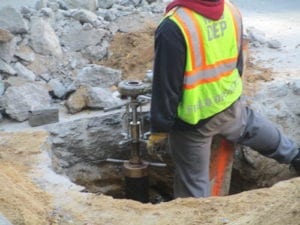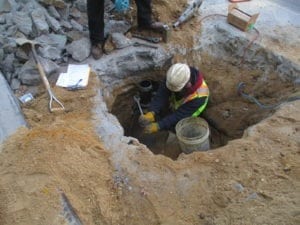First, it is important to determine if the water pressure problem is an ongoing issue that has been a problem for several years or is this a problem that has occurred recently?
If the pressure problem is an ongoing issue, you should first start with a water pressure test at the location of where the main water line enters your home. Most of the time, your plumber will disconnect the water line at the meter and utilize the pressure gauge at this point.
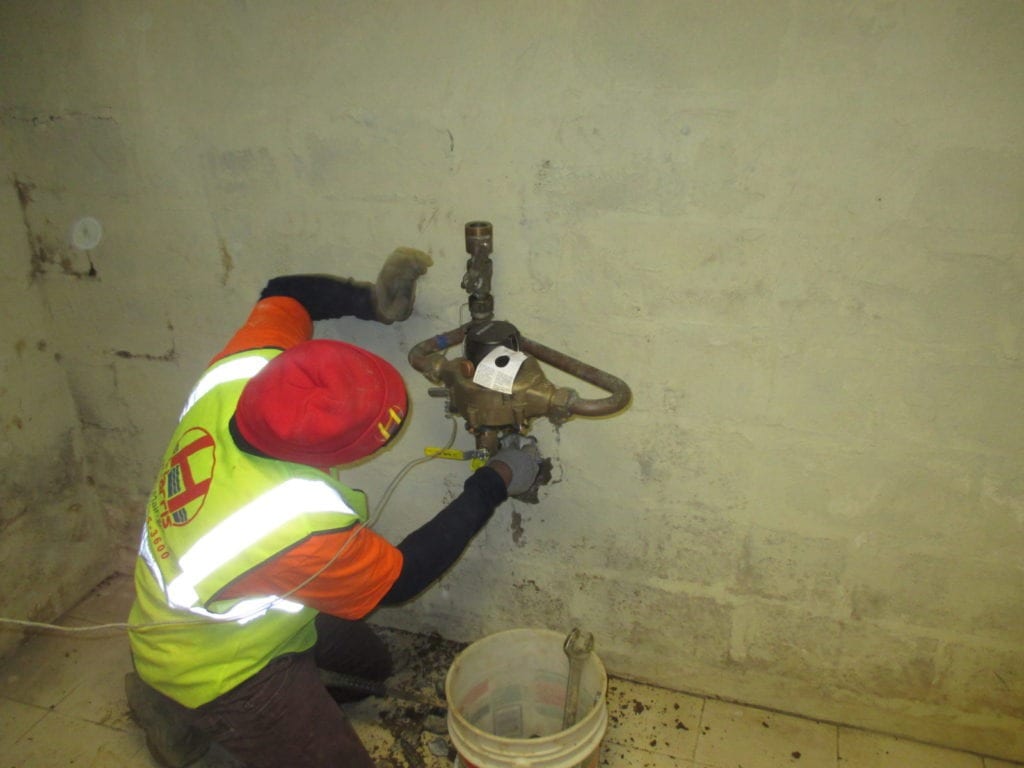
Location for pressure test |
Your water pressure should be anywhere in between 40-60 PSI (pounds per square inch). Most homeowners prefer to be right in the middle at 50 PSI.
If you don’t have the resources or time to have a professional water pressure test there is a very simple alternative known as the multi-flow test. Run your washing machine along with two showers and two sinks throughout the house. Next you should flush one or two toilets and if the pressure does not appear to be strong enough throughout the house, you should increase your water pressure.
If the pressure gauge test shows that you have good pressure from the street, you should start to investigate the internal plumbing throughout your home. This will become a process of elimination to determine exactly where the problem is or if the problem persists throughout the entire house.
In many cases, the internal piping throughout the house is the original piping from when the house was built and is undersized for the number of plumbing fixtures in the house. Another possibility is that the inside of the piping has become corroded over the years resulting in restricted water flow.
Think about is this way, if you have a 3/4″ water main that has 60 years of corrosion build up inside the pipe the inner circumference is no longer 3/4″. The inner pipe may actually be 1/2″ or smaller pending the amount of corrosive build up over the years.
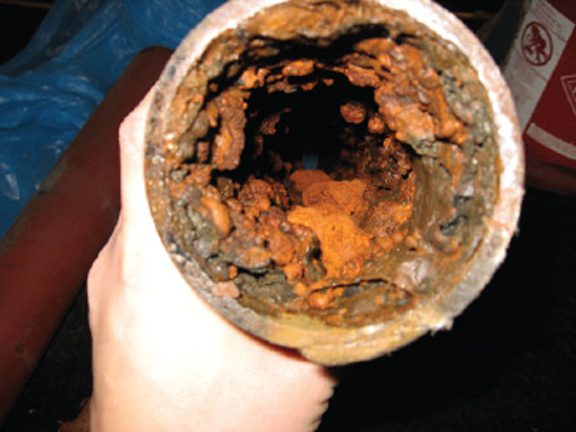
Corrosion of water main |
The resolution would be to replace the sections of pipe you have diagnosed to be the problem or replace all of the internal piping to stay ahead of any future issues and eliminate what may be a lead piping.
If you have lead piping carrying any water into your home it is always suggested to replace the existing piping to avoid any health issues with the lead pipe.
If the pressure test has determined that the problem arises from the water main in the roadway, you should contact a subsurface water main and sewer specialist to begin investigating, as well as the local town or city who regulates the water.
The town or city should test the water pressure from the public main. Another way to test the city main pressure and avoid weeks or months of calling is to consult with your neighbors. If 85% of the houses on your street have sufficient pressure, it is safe to assume that the problem is isolated to your home.
Next, it is best to have the licensed plumber obtain city records to determine the size and material of piping from the street. In NYC these records are known as “tapping records” which refer to the valve that connects the water main to the city water service (tap connection).
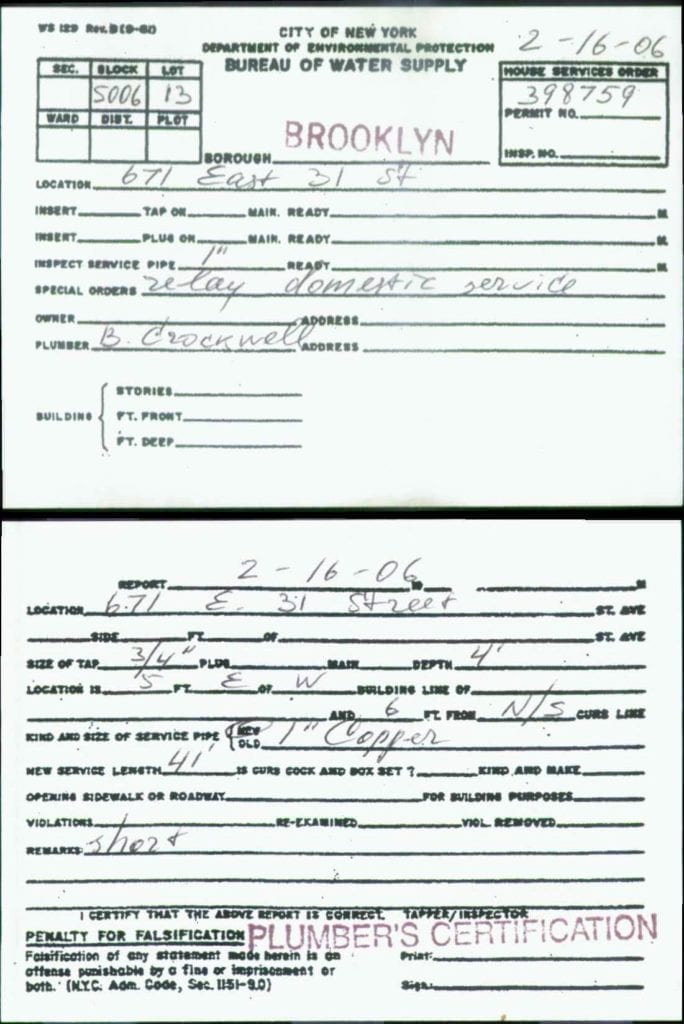
Tapping records |
Tapping records usually include the material makeup of the pipe, size of the pipe, size of the tap connection, depth, if there was a repair completed and the location of the connection. At this stage, you would be looking at the material makeup and the size to assist in understanding the cause of your pressure problems.
In the NYC plumbing code book, there are several tables used to determine the rate of flow that is required to service a specific amount of plumbing fixtures in a building. The tables factor the distance the water will travel, rate of flow and the total amount of plumbing fixtures.
These tables will ultimately determine what size pipe and tap connection is required to provide adequate volume and pressure into the building.
Many homeowners assume if they increase the size of the water main pipe that they will have more pressure into the home. This is a major misconception as the size of the pipe is not the only factor. It is essential to understand that the tap connection is what controls the volume and pressure from the city main into your private water main. If you have a 3/4″ tap connection and increase your pipe from 1″ to 2″ you will not experience any increase in pressure. It is important to consult with a licensed master plumber who has knowledge and experience when reviewing the tables included in the plumbing code-book.
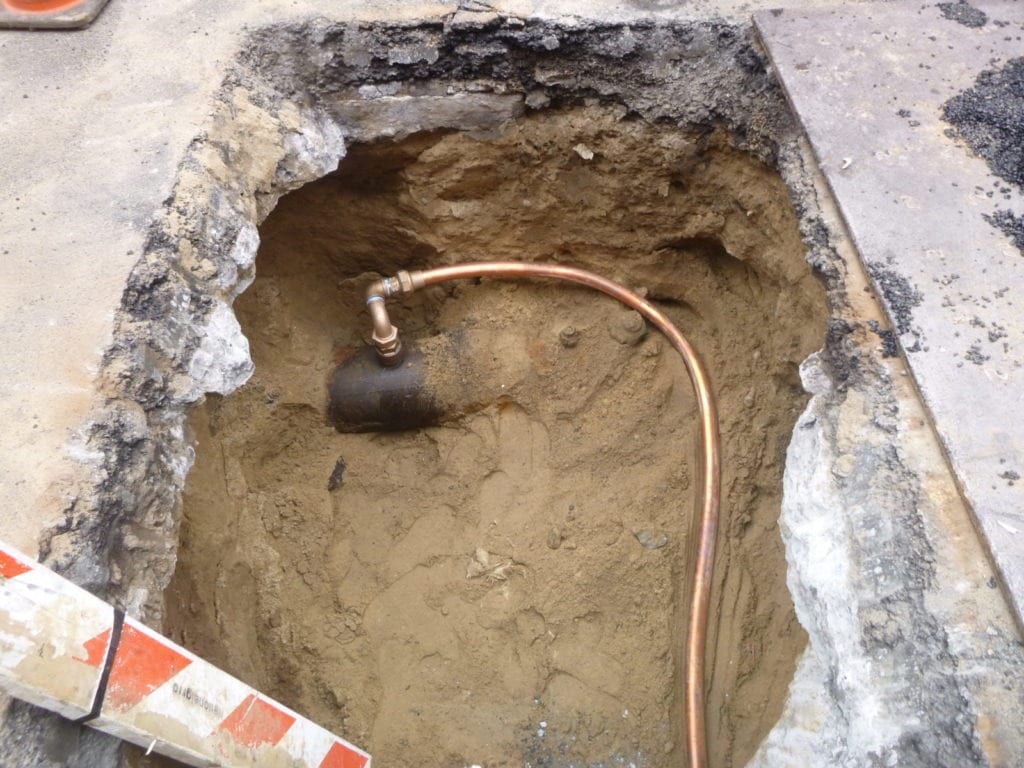
Water main and tap connection to the city main |
If the city does not have any records on file for hour property you can try and obtain records from the neighboring buildings to get an idea of what size pipe or main your house has, however, this information should not serve as factual information. Information on the neighboring buildings is only used to assist in understanding the layout for your street.
If it has been determined that the size of pipe and tap are not sufficient, it is time to identify what size is required and start scheduling the replacement of both the tap and water main. The entire process is pretty quick once the permits are issued and takes 1-2 days pending the specifics of your location.
The licensed plumber is responsible for 99% of the work, everything from digging the roadway, preparing the city main for the city to installing the pipe. The plumber is required to schedule a time for the city to arrive and install the tap. This appointment is extremely time sensitive as the city will not wait for an extended period and will require the plumber to reschedule if they are not ready for the new tap installation.
Assuming the plumber has completed the excavation and prepared the city main, the city employees will take anywhere from 15-30 minutes to install the tap before moving on to the next job.
DEP installing tapDEP installing tap
|
If you have added plumbing fixtures to the home or plan on doing so in the near future it is a good idea to review the plumbing fixture unit table and see what is required for your home. Commonly, a homeowner or contractor will not become aware of the water pressure problem until people move into the house and start to utilize the plumbing.
You may first become aware of the pressure problem after your sister or one of the tenants are using the shower on the top floor while you are utilizing the washing machines in the basement. It would be terrible to think that you were celebrating the completion of your construction to become aware that you have to replace the water main! It is always suggested to consider these factors before closing up the walls and completing the landscaping.
Another reason for a loss in water pressure would be if the water main is leaking at some point between the house and the city main. Many people think that if there is no sign of the pipe leaking, then it is impossible that the water main has sprung a leak. To the surprise of many a water main may leak for weeks or even months before surfacing on the property, sidewalk or in the roadway. It is also surprising that your water main may be leaking and show up in front of your neighbors house 100′ away.
The best option for determining a water leak is performing a noise test. Your licensed plumber should use a listening device on the pipe inside your home, with a trained ear he should be able to determine if the pipe is leaking or not. If there is any questioning at this stage you should contact the city and have them perform their own investigation and perform the same test on your neighbors home if needed.
The water main repair process is a standard process that occurs many times each day throughout NYC. When a homeowner receives notice that their water main is leaking it is common to feel scared and helpless. Please be mindful that this is a common occurrence and you are not alone. The process for repair is usually completed in one day and for the most part, is a seamless process.



